Table of Contents
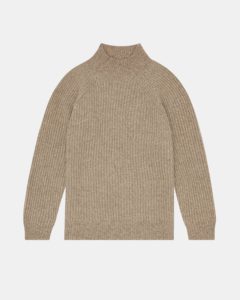
Our top pick
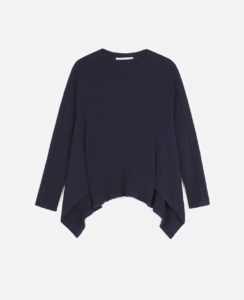
Third pick
There’s no denying wool is a miracle fiber. Sheep and goats did very well when they figured out how to insulate themselves against the cold and heat, and we can certainly benefit from their evolutionary prowess. The problem, though, is that while cashmere (which comes from goats) is a beautiful, buttery soft, super functional fiber, it’s typically not very sustainable. In fact, cashmere is one of the most environmentally destructive fibers used in clothing.
If you’re coveting a new cashmere sweater, though, don’t worry. There’s still hope. A handful of companies now offer sustainable cashmere sweaters, some using recycled cashmere and others carefully sourcing yarn from ethically managed goat herds that actually enhance biodiversity. Here are my top picks for the best sustainable cashmere sweaters currently available, followed by a short summary of the ethical and environmental problems of cheap cashmere.
Curious about how we rate products? Click here to view our methodology, which at its core, is about voting with our dollars to fight climate change.

Riley Studio
Highlights: Beautiful cashmere sweaters made from 95% recycled cashmere and 5% extra fine merino wool, by a company dedicated to circularity and positive business practices.
Riley Studio is dedicated to circularity, creating beautiful cashmere sweaters and other pieces using pre- and post-consumer cashmere from all over the world. These gorgeous pieces are crafted in London using 5% extra fine merino wool and 95% Re-VerSo™ yarn, which is milled in Italy from factory off-cuts of cashmere and yarn spun from recycled cashmere clothing.
This means you get the same quality of garment as with virgin cashmere, but a much smaller carbon footprint, water footprint, and environmental footprint overall. Re-VerSo™ is certified to the Global Recycling Standard.
I also like that Riley Studio has a gender-neutral sizing style (0-5) and exceptional traceability of materials. Their cashmere collection is knitted by Albion Knitting in the UK, using Re-VerSo™ milled by Filipuci in Italy. Their design approach is to create wardrobe staples that are eco-friendly and last for life, not just a season. Riley Studio also takes pride in fair labor standards, with their factories SMETA audited to ensure a safe and fair work environment.
Riley Studio is also a strong promoter of conscious consumerism and positive marketing, aiming to be ageless, diverse, and gender-neutral. They produce all their clothing in small runs, so as to not overproduce and create waste. They even offer an Earth-friendly guide to cashmere care and a lifetime guarantee, meaning that if your sweater needs repair, you can contact them for help!
Finally, Riley Studio collects your old pieces from their collection and will recycle them back into the system. Along with beautiful recycled cashmere sweaters, Riley Studio also make sustainable cashmere socks, scarves, and beanies.
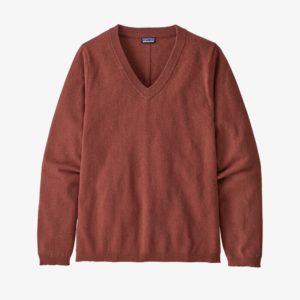
Patagonia
Highlights: A well-known, highly-respected brand making quality cashmere using recycled cashmere in fair labor factories.
Around 2017, many brands started to seriously scrutinize the sustainability of cashmere, with many ditching the fabric altogether. Patagonia was one of these companies, but now their cashmere line is back and better than ever, thanks to recycled cashmere.
Patagonia use pre-consumer recycled cashmere from fabric scraps sourced from European factories. Their sweaters are made in fair-labor factories in Vietnam and China with 95% recycled cashmere blended with 5% virgin wool. Prices start at $139 and the company offers international shipping. The company is also well-known for being an industry leader in sustainability, which is why they also make the cut for Leaf Score recommended winter coats, winter boots, and sustainable swimwear.
Patagonia also provide an easy way to find used cashmere items through their WornWear initiative. They estimate that buying used extends a garment’s life by about two years and cuts its combined carbon, waste and water footprint by 73%.

Stella McCartney
Highlights: Luxury cashmere clothing made with recycled cashmere from a company also invested in restoring devastated Mongolian grasslands.
At the luxury end of sustainable cashmere, Stella McCartney is, as in many cases, leading the way. The designer (and company) is strongly committed to sustainability and ethical fashion, making cashmere sweaters from recycled fibers in a range of colors and designs.
The sweaters are made in Italy using ReVerSo™ yarn and comprise 95% recycled cashmere and 5% wool. Making the decision to switch from virgin cashmere to recycled reduced the company environmental impact from cashmere by a whopping 92%, according to a calculation using EP&L. Stella McCartney notes that cashmere has nearly 100 times the environmental impact of wool, and by using ReVerSo™ they are following through on their commitment to make fashion circular, i.e., regenerative and restorative by design.
Another great thing about Stella McCartney is that the company didn’t just quit virgin cashmere and switch to recycled. They are also working alongside the Wildlife Conservation Society to help restore the Mongolian grasslands devastated by the cashmere industry. This involves supporting sustainable production where herders are paid a fair wage to incentivise and enable better quality products and land management practices.
Stella McCartney sweaters are tailored to be gender neutral and start at $570 with international shipping available.
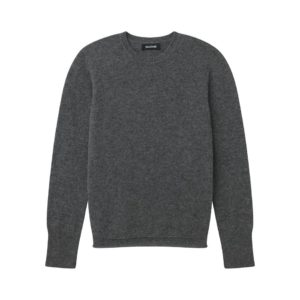
NAADAM
Highlights: A highly transparent newcomer to the cashmere scene, making gorgeous cashmere sweaters using directly sourced fibers from Mongolian goat herders. NAADAM has excellent ethics and estimable plans to further enhance their sustainability.
NAADAM was founded in 2013 with the goal of creating cashmere clothing with a commitment to “transparency, ethical practices, cultural preservation and environmental sustainability.” Their cashmere is sourced directly from Mongolian goat herders who graze their animals in the Bayangovi region, which is less fragile and vulnerable to desertification than nearby areas.
The goats that provide the cashmere for NAADAM are hand-combed in a traditional and gentle way. The herders are paid higher prices and receive benefits such as health care and livestock insurance, as well as veterinary care funds. NAADAM also sets herding limits and makes sure goats are overwintered in a very large area (the size of Manhattan) to minimize overgrazing. The company also invests in the local community in other ways, through a partnership with the Gobi Revival Fund.
The cashmere is spun in certified mils in China that use natural and biodegradable dyes and have a closed-loop filtration system for water. About 90% of NAADAM’s products in 2019 were made at two key suppliers in Chifeng who are audited against the Business Social Compliance Initiative framework. All of NAADAM’s suppliers must have documented labor and environmental certifications verified through third-party audits.
The company recently published their first annual Social and Environmental Impact Report, which formally outlines their commitments and framework on people, product, planet and progress through 2025. Among their goals are to go carbon neutral by reducing emissions, investing in offsets and prioritizing renewable energy, and to reduce packaging and switch to sustainable alternatives. They are already a carbon-free freight shipper.
NAADAM’s inserts and hangtags are made from 100% pre-consumer Forest Stewardship Council-certified recycled paper and their mailers and bags are made of 100% recycled plastic. These plastics use non-toxic chemicals and Breakdown Plastic (BDP) technology to help plastic biodegrade to leave nothing but organic matter in a couple of years.
The report also notes that in 2019, 100% of materials used by NAADAM came from renewable or recycled sources, with more than 99% natural fibers — cashmere, wool, silk and cotton. In early 2020, they introduced an internal preferred purchasing policy that prioritizes the use of natural materials with environmentally-preferable characteristics, including industry standard certifications like Global Organic Textile Standard (GOTS), OEKO-TEX®, Responsible Wool Standard and Global Recycled Standard (GRS). NAADAM also donates returned products and damaged products to charitable organizations for reuse or to a rag-making manufacturer.
NAADAM are also looking to achieve B Corporation certification, which is always a good sign that a company means to do good things going forward, given the accountability involved in that process. If NAADAM does manage to establish a circular, regenerative system whereby their own cashmere products can be recycled into new products, this may bump them up to 5/5 leaves. For now, because they use only virgin cashmere, their environmental impact is still higher than that of recycled cashmere.
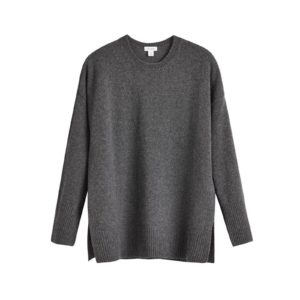
Cuyana
Highlights: GRS certified recycled cashmere and other ethical clothing made with natural materials. Not quite so engaged as Riley Studio and others, though, but less expensive than Patagonia and Stella McCartney cashmere sweaters.
Cuyana make a range of ethical clothing using a wide variety of natural materials. Their cashmere range includes sweaters, turtlenecks, and cardigans and is made with recycled cashmere. Prices start at around $145 and these pieces are fantastic if you’re putting together a capsule wardrobe or just looking for timeless clothing that is high quality and sustainable.
Cuyana’s sustainable cashmere sweaters are made using at least 95% recycled cashmere fibers. Manufacturing takes places in Italy at a family-owned mill that has been around for more than 130 years. The mill is devoted to sustainable practices and is accredited with the Global Recycle Standard certification. They are adherents to the Detox Solution Agreement established by Greenpeace to eliminate all harmful substances in production processes.
Cuyana offer free returns in the US and a two-year warranty on most items. The company doesn’t quite match up to Riley Studio, Patagonia, or Stella McCartney, however, for their other sustainability and ethical initiatives, which is why I’ve only given them ⅘ leaves.
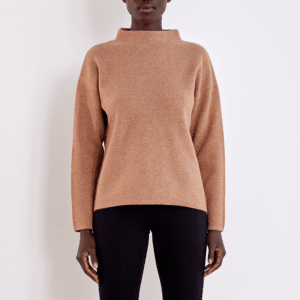
ADAY
Highlights: Innovative clothing company making most items with recycled, regenerated, and natural fibers in OEKO-Tex and Bluesign certified factories. Their cashmere sweaters are mostly non-mulesed wool (73%), however, with 27% recycled cashmere.
ADAY is a sustainability minded, ethical clothing company that offers a range of gorgeous garments including sweaters made with 73% certified non-mulesed wool and 27% recycled (pre-consumer) cashmere (hence the ⅘ leaves, given this is mostly a wool sweater, not cashmere). In fact, 70% of ADAY’s range is made with recycled, regenerated, and natural materials, with the aim to get that to 100%. Some 91% of their range is also vegan-friendly.
As for the wool in the cashmere-wool sweater blend, this comes from sheep farms in South Africa and Australia that are certified as not using mulesing practices. The mills ADAY uses are also certified for the Global recycled Standard (GRS), Responsible Wool Standard (RWS), and include Woolmark and Woolmark Blend Certified manufacturers.
The company visits their mills in Italy and Taiwan regularly to audit for the environmental footprint and labor standards. There is also mention of mills in Turkey and China, but these aren’t included in their eco-friendliness audit report, strangely. As for the Taiwanese (2) and Italian (4) mills, these all have recycling policies and efficient machinery in place to cut their environmental impact, while all but one of the mills reuses and purifies water. Two of the Italian mills have solar panels installed, and all of the mills are OEKO-Tex 100 certified, with both Taiwanese mills also Bluesign certified. Some fabrics also adhere to REACH standards.
ADAY also offer a carbon offsetting program, with 100% of whatever you add to your order going to Cool Effect, a non-profit that uses at least 90% of every dollar to fund projects such as reforestation, carbon sequestration, and renewable energy investments. The company is also transparent about its commitment to support diversity and inclusion, with both financial and operational actions backing up their words.
ADAY also encourages reuse and recycling of their clothing, with store credit available if you can prove you gifted an older ADAY item to a friend to extend its life. You can also drop off or send old ADAY items to their offices for credit (email them for a pre-paid label), with the company aiming to eventually achieve a closed-loop system where old ADAY becomes new ADAY.
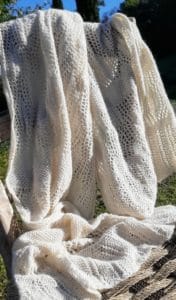
Chianti Cashmere
Highlights: One of the few companies making virgin cashmere products in an ethical, and enterprising, way, using fibers from their own goat herd in Italy.
Chianti Cashmere are a standout company in this list because they are explicit about using virgin cashmere that is sourced ethically from their own herd of goats. Or, as they call them, their teams of goats, which they will rent out to help you with your land management projects if you happen to live in Tuscany, where they are based. Chianti Cashmere offer both finished garments and cashmere yarn for knitters and crafters.
Chianti Cashmere was founded back in the 1970s by Nora Kravis, who left Long Island, New York, for Italy. She bought a rundown farmhouse and estate and established a smallholding, eventually getting a couple of goats, which soon turned into many goats (as they do). Kravis is a veterinarian, and the herd of goats at Chianti Cashmere is now internationally recognized for its pedigree and as, most likely, the first privately owned cashmere goat herd in Europe.
These days, Chianti Cashmere’s teams of goats are involved in a variety of controlled grazing projects, where they help to clear, reclaim, and improve private and public farmland and maintain marginal and abandoned farmland in a sustainable fashion. Far more eco-friendly than heavy machinery, herbicides, and other blunt instruments of land management, goats naturally graze blackberry brambles, hawthorn, thistles, and other unwanted plants to tackle overgrown areas without decimating biodiversity and soil quality.
The Chianti Cashmere herd is also certified Wildlife Friendly, meaning that traditional methods are used to protect the goats (such as guard dogs), that help avoid harm to predator species such as wolves, wild boar, and bears.
The cashmere fiber used by Chianti Cashmere comes only from their goats, meaning they can be sure the animals have never been tied or tethered or treated with hormones or other chemicals. The goats only graze on untreated farmland, and the fiber is processed without chemicals or industrial colorants.
Want to meet the goats? You can! Chianti Cashmere offer a Goat Camp and Combing package, and you can also stay at the farmhouse on the original property. Every goat has a name and (apparently) answers to it, and they enjoy a far longer and happier life compared to intensively raised goats (10-15 years compared to around 5-7 years). The goats are hand-combed to help remove their winter coats, which they would otherwise do by combing themselves against brambles and bushes.
For traceable, sustainable, virgin cashmere, Chianti Cashmere really seems to be the GOAT (greatest of all time).
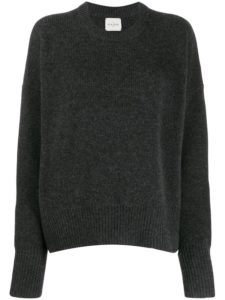
Le Kasha
Highlights: A high-end fashion brand that’s been around for more than a century, Le Kasha makes cashmere sweaters using virgin fiber from Mongolian goats grazed sustainably and with ECO Label certification.
High fashion, high quality, and seemingly sustainable but lacking a little in terms of transparency.
Le Kasha is one of the oldest and most venerated brands making cashmere clothing. The company has been around since 1918 and is credited with a women’s style revolution in the 1920’s. Coco Chanel used Le Kasha’s cashmere to create her first suit collection, for instance. More recently, Le Kasha has upped its game to reflect the move towards greater sustainability in the fashion industry.
All of Le Kasha’s pieces are designed in Paris and produced in a single factory in Mongolia, so as to minimize the company’s environmental impact. Le Kasha also makes sure to work with farmers and herders in the Alashan and Arbus regions of Inner Mongolia who practice sustainable grazing that helps preserve the land rather than contributing to desertification.
The company carries ECO Label certification to back up the claim that the goats that produce the cashmere fibers are treated well. This includes being grazed in a sustainable manner on natural grasslands that are free from fertilizers and other chemicals.

Reformation
Highlights: A generally great company making innovative eco-friendly clothing using recycled materials, though their cashmere sweaters are made with a 70/30 split of recycled to virgin cashmere that isn’t certified as sustainably sourced, sadly.
Reformation were one of my top picks for sustainable swimwear and happily they also make cashmere sweaters! Based in LA, Reformation use a blend of recycled and virgin cashmere (typically 70:30), which helps save significant amounts of CO2, water, and waste.
Prices start at $148 for Reformation’s sustainable cashmere sweaters, cardigans, and wraps, which are made in China in a variety of colors and sizes. They ship worldwide but don’t offer much in the way of a warranty or reassurance that the virgin cashmere is sustainably sourced or processed in a non-toxic fashion, unfortunately.
What is cashmere?
Cashmere is a type of wool that comes from the undercoat of a Kashmir goat. Kashmir is the disputed territory between India and Pakistan and is where pashmina scarves are traditionally made. Over time, Kashmir goats have also been raised across Central and Northern Asia, including in Tibet and Nepal, as well as China, Mongolia, Iran, and Afghanistan. Every cashmere sweater requires wool from around 4 cashmere goats.
Why is cashmere so beloved? The fiber, which is technically a microfiber, is very similar to wool in terms of its insulating properties, even when wet. It is also very light and breathable, has excellent moisture-wicking capabilities, and is even a little stretchy. This makes it a great fiber for making socks, sweaters, scarves, gloves, coats, hats, and thermal wear. Cashmere is also resistant to wrinkles and exceptionally soft, with a luxurious feel even at the lowest grade compared to wool. The grades are based on the size of the fibers in microns, the finest being the Grade A cashmere with fibers as small as 13 microns. Most human hair is 75 microns, for comparison.
There are a few downsides to cashmere, namely that it is prone to pilling and can be more easily damaged than other fabrics as it has such short and fine fibers. This means it pays to be a bit more careful with how you care for your cashmere.
The other major downsides of cashmere, however, are to do with the ethics of goat herding and the environmental impact of a cashmere industry run rampant.
Sustainable cashmere certifications
There’s currently no fair trade certification for cashmere, but there are a few other logos and labels to look for that offer some guarantee of greater sustainability and a more ethical cashmere product.
The Good Cashmere Standard – Launched in early 2020, so still picking up steam, this standard was developed by the Aid by Trade Foundation (AbTF) and aims to certify retailers, mills, farmers and ready garment manufacturers as adhering to a better standard of animal welfare, worker and community welfare, and environmental protection.
The Sustainable Fibre Alliance (SFA) – In 2015, the SFA developed the world’s first holistic sustainability standard for cashmere – the SFA Cashmere Standard. This is used to certify producers who meet certain standards for practice in land management, animal welfare, fibre processing and supply chain transparency. You can check their current members list here.
Global Recycled Standard (GRS) – Relevant for wool and cashmere products, as well as synthetic textiles, the GRS logo offers assurance that a ‘recycled’ garment comprises a minimum amount of genuinely recycled fabrics.
The environmental toll of cheap cashmere
The cashmere crisis is not new. In fact, alarm was being raised over the environmental toll of cashmere back in the 1990s. Despite its critics, the production of and market for cashmere boomed in the early 2000s, with massive increases in grazing as more and more goats were needed to meet the demands for the fiber.
All that grazing has led to widespread desertification of previously rich grasslands. Now, farmers struggle to find enough grassland to feed their goats, with many having increased their herd size significantly to meet demand for cheap cashmere only to find that they are paying more in grain to keep their animals alive than they get back for the fiber. Many of the goats now have a much shorter lifespan than their parents and fewer goats are being born each year. The cashmere, too, is changing, with poor feed leading to shorter, coarser, hair that is lower grade and less lucrative.
Desertification also creates huge dust storms, which ruin the air quality in the region, especially as the dust mingles with pollution to create thick smog that means local residents are warned to stay inside. These dust storms have even been tracked all the way from China to North America where they have adverse effects on air quality in many parts of the US, and as far east as the Canary Islands. More locally, governments are having to ration water, with some systems shut off for days at a time to manage supplies.
All of this demonstrates that cashmere is a limited resource, with goats taking a serious toll on fragile pasture. Without grass and shrubs to hold the land together, Mongolian deserts are expanding by hundreds of square miles every year. The region is also experiencing serious impacts from climate change, in part caused locally by desertification and altered weather patterns. A 2011 report found that Mongolia’s average temperatures had risen 3.85°F since the 1940s.
Cashmere originating in Mongolia has over 36 times the negative environmental impact of wool, according to Kering’s EP&L. Many different strategies are being tried by China and Mongolia to reclaim grassland. In Inner Mongolia, grazing has been banned on more than a third of the province, some 163,000 square miles.
All in all, the increasing awareness of cashmere’s environmental impact means many brands are turning away from virgin cashmere from overgrazed Asian countries. Instead, the focus is on creating a circular cashmere loop where the fibers already in existence can be recycled time and again. Alternatively, some producers are looking at ways to gather virgin cashmere with a positive impact on the environment, such as through controlled grazing as a part of natural land management practices (see Chianti Cashmere above).
The human and goat ethics of cashmere
Kashmir goats grow coats to insulate themselves against harsh winter temperatures, then shed these in the warmer months. In the wild, the goats use coarse shrubbery as a natural comb, leaving the soft, downy fiber tangled in the branches. When raised for their fiber, cashmere goats are sometimes hand combed in a manner that doesn’t kill the goat nor, in most cases, cause any injury or pain. Some herders do shear the goats, though, which can cause cuts and abrasions. If they shear the animal too early, the goats can freeze to death.
Still, to make one sweater requires the hair from four goats, at least. And all of these animals have been raised, and potentially suffer, just for that sweater. Most of the animals have to be restrained in some manner in order to comb or shear them, and this in itself can lead to injury and extreme stress.
In addition to the suffering of the goats, the cashmere industry also has a poor track record for human rights. Many workers all along the supply chain are subjected to unfair pay (if they’re paid at all), and unsafe working conditions. And the cashmere may be mixed with synthetic fibers, bleached, dyed, and otherwise subjected to chemical treatments that can harm the workers.
When things are done properly, cashmere can provide an excellent livelihood for herders and a generally happy life for the goats. Some brands are beginning to look at direct trade options with goat herders, which can help raise wages and living standards and ensure a more secure, safe, and non-toxic supply chain.
Ok thanks..now there is another product that I can’t buy .
I just buy wool instead